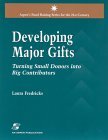Developing Major Gifts: Turning Small Donors into Big Contributors
"A major gift is a well-thought out personal decision, " says Laura Fredricks, author of Developing Major Gifts: Turning Small Donors into Big Contributors. Although there are numerous articles that address the subject of major gifts, new contributions to the literature in book format have been few in the past five years. Fredricks' book is not only timely, but also quite comprehensive. A competent mentor for fundraisers, Fredricks' intention is to shepherd readers through the labyrinth of major gifts and to help them find their own fundraising voice and style, and she achieves this goal admirably.
Developing Major Gifts: Turning Small Donors into Big Contributors is a part of Aspen's Fund Raising Series for the 21st Century. Typical of this series, the information is thorough in its research and documentation. Beginning with the definition of a major gift, Fredricks goes on to discuss how to start a major gifts program, preparation of the gift proposal, making the ask, thanking and recognizing donors, and tracking of prospect activities and gifts. The publication ends with three case studies.
Laura Fredricks is well qualified as a spokesperson on the subject of major gifts. She is currently employed as the senior director of major gifts at Temple University in Philadelphia. Prior to this appointment, she served as major gifts manager for a hospital foundation in New Jersey. She holds degrees in journalism and law and she formerly held the position of deputy attorney general for the Commonwealth of Pennsylvania. Frequently, she teaches nonprofit and business management courses in major gifts fundraising at the University of Pennsylvania, Duke University, and the Smithsonian Institution.
The presentation format of Developing Major Gifts is pleasing, with material highlighted and blocked to assist the reader in readily finding the most pertinent material. Valuable tips are graphically set off throughout the manuscript. Additional user-friendly aids are supplied by the suggested reading list, recap, and review which follow each chapter. In addition to its easy-to-read format, this manual includes a bibliography, an index, and a resource list of web sites for prospect research. Appendices provide excellent examples of such things as sample personal calendars (daily and monthly variety); letters; gift proposals; cash-flow analysis; phone conversations with hypothetical dialogue; gift crediting and acceptance policies; major gift reports and tracking forms.
The relaxed voice of the narrative, interjected with intermittent humor, does not undermine its serious instructional framework. Peppered with quotes from actual donors on how and why they give, the tone of the text is such that novices as well as veteran fundraisers can relate to the author's message of how one motivates, inspires, energizes, and organizes major gift prospects. In her creative and enthusiastic style, Fredricks reveals tried-and-true methods on how to best plumb these prospects.
For citations to other materials on this topic, refer to the Literature of the Nonprofit Sector Online, using the subject heading "Major gifts campaigns".







